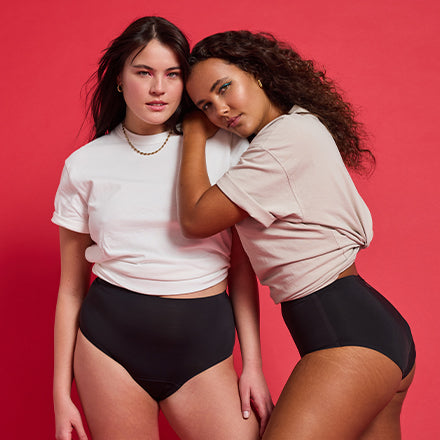The history of menstruation: managing periods through the ages
The history of menstruation is a classic rags-to-riches story — rags in the literal sense and riches in that what a fortune it is to finally have comfortable and hygienic period products.
Throughout the ages, menstruation has had a reputation for being shameful and unpleasant and, at times, even powerful and magical. While we love a bit of magic, times have really changed, and so have the ways we manage menstruation. The evolution has been enormous, and we’ve traded toad powder and sticks wrapped in cotton for period undies, cups and tampons.
So what did cavewomen do on their period back in the day? How did they handle menstruation in Ancient Greece? And what was the average age of menstruation throughout history? Come with us as we flow back in time to look at how we managed menstruation throughout each era and as we get a little dose of appreciation along the way for how different things are today.
What did cavewomen do on their period? The lead-up to the 4th century
Ever wonder what we did in a time before pads and period undies? Even from the Stone Age, the history of menstruation shows some ingenious (and uncomfortable) approaches to navigating periods.
Interestingly, evidence also shows that Paleolithic women menstruated much earlier, with periods starting between 7 and 13 years of age.
Here are a few milestones in period management worth noting:
- The earliest records of period management suggest that women in the Stone Age (circa 30,000 BCE–3,000 BCE) had rudimentary pads made of leather and linen-wrapped moss and sand.
- Ancient Egypt had reusable loin cloths and basic tampon-like devices made of papyrus and grass.
- Hippocrates said women in Ancient Greece would wrap lint around wood or fashion homemade rags to catch the blood. The blood would also form part of ceremonies and rituals, like the spring festivals when they would spread it on the earth to increase fertility.
- Ancient Equatorial African women used grass mats and rolled-up grass to absorb blood.
As we moved towards the Middle Ages, attitudes around periods started to become more shameful. And, evidently, the products for managing cycles reflected this.
Periods in the Middle Ages
The shame around periods kicked into high gear in the Middle Ages (5th–14th century). Due to influences from religion and a lack of understanding of biology, menstruation was pretty taboo.
Beliefs that menstrual blood could kill crops, dull mirrors and even give someone the ability to shoot poisonous vapours through their eyes were common. And to stem a heavy flow, wearing a powder made of dried toad around the waist was just one of many peculiar solutions.
During this era, the most common approach to managing blood was using cloth rags as DIY sanitary pads. Other evidence suggests that those experiencing their cycles caught their blood with absorbent bog moss.
While there was certainly a demonstration of ingenuity, sadly the Middle Ages lacked positive attitudes and effective period management products for those living during this time.
The Modern Age: not so modern
During the Modern Age (15th–19th century), periods were still taboo. It’s no shock then that people kept menstruation products secret — and rudimentary at best.
Around this time, women had to place cotton and flannel inside their bloomers when they had their periods. As it was blatantly unhygienic, a rubber apron was invented to place between their undies and the blood flow. The rubber did a great job of protecting furniture and clothing from blood, but for the wearer, they were uncomfortable and had an unpleasant smell.
So how did they deal with periods in the 1800s? In this era, menstrual belts became a thing. These cloth belts could be fastened to the underwear — like a modern-day pad — and the absorbent fabric would help catch much of the blood.
The use of such devices wasn’t shared by everyone, however. In Europe, women of lower classes had to bleed into their clothing. As bathing was also trickier because private baths weren’t the norm, this part of the history of menstruation was much less hygienic.
20th century: let’s get commercial
In the lead-up to the 20th century, the stock standard ‘rags’ were still being used, where bits of cloth were simply stuffed between the legs to catch the blood. Usually, some sort of girdle or tight-fitting underwear held them in place.
Commercial sanitary napkins emerged as World War I led to the broader use of surgical dressings. Sfag-Na-Kins, pads made with naturally absorbent and antibacterial sphagnum moss, were an unsurprising failure.
In 1921, Kotex napkins were born. Made with cellucotton and covered in a gauze sheath, this is when the feminine hygiene product market finally began. And it would take another ten years for tampons to make it into the mix.
Initially used in medical practice to stop bleeding from deep wounds, tampons weren’t always destined to be used during periods. It was only after we realised we could also effectively introduce medicines into the vagina that the first successfully marketed period tampon arrived in 1931. Say hello to the Tampax, everyone.
Today’s period products
Today, period management looks a little different. From reusable pads to menstrual cups, there are a plethora of ways to manage your cycle.
As one of the most recent revolutions in the history of menstruation, period undies are a comfy, hygienic and protective way to manage periods. In 2013, we launched the first pair of leak-proof undies in Australia, forever changing the period products landscape. The rest, as they say, is history.
Since then, we’ve launched a variety of period undies in a range of cuts, colours, prints and absorbencies, so no matter your style or flow, we’ve got you covered.
It’s not just the products that have evolved, society’s attitude surrounding menstruation has also improved.
Nowadays we’re comfortable discussing periods, we approach them with inclusivity, and we understand that they’re different for every person. And hopefully, the future will only get better.
Period undies that stand the test of time
The OG of period undies, Modibodi has a range of period undies to suit every body and every type of bodily fluid. With patented leak-free tech that goes into every pair, you can feel comfy and confident going into each and every day. No dried toads required.







